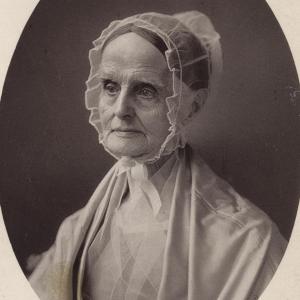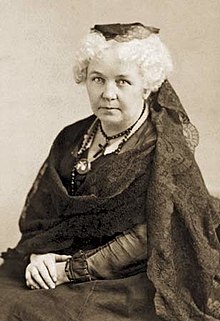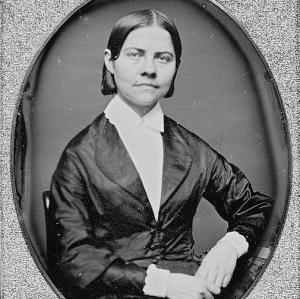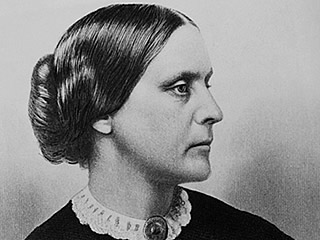Last week, we celebrated the 100th anniversary of women’s suffrage in America. It is an amazing milestone to hit and to honor, but, on the other hand, it is shocking to think that the female citizens of this country have only had the right to vote for one hundred years. There are so many stories, people, and events that went into the long fight for the 19th Amendment, but in these next two posts I have compiled the events and stories that I feel were most important and encapsulated the movement.
Seneca Falls Convention, July 1848
The Seneca Falls Convention in 1848 sparked the women’s suffrage movement in America. The event was organized by five women: Elizabeth Cady Stanton, Lucretia Mott, Mary M’Clintock, Martha Coffin Wright, and Jane Hunt. It took place in the small town of Seneca Falls, New York. This convention was an early introductions, worldwide, of the concept of women’s suffrage. But how did this convention suddenly come about?
The abolition of slavery was one of the first political movements that women participated in and were able to exercise political agency. Beginning in the 1830s, American women were speaking out against slavery in public lectures. A woman’s role, during this period, was to be stowed away in the “private sphere”. They were to be dutiful wives and take care of the children. Being regulated to the household, women never had a chance to reach out further and participate in the public sphere. They were barred from taking an active role in politics. To society, their opinions were unimportant. After a woman married (which was expected of them) they would lose any few freedoms they had and were dependent on their husbands. Married women had virtually no property or financial rights and the option of divorce was near impossible. The ideal “True Womanhood” of the period was a wife/mother who was pious and submissive. By the eyes of the law, women were dependents rather than a true citizen.

Elizabeth Cady Stanton and Lucretia Mott were involved in the abolition movement and, in 1840, went to London to speak at the World Anti-Slavery Convention. Yet, they were denied participation due to their sex. This is the event that is believed to have to resulted in the planning on the Seneca Fall Convention.
At this convention, Stanton recited her “Declaration of Sentiments” which began:
“We hold these truths to be self -evident: that all men and women are created equal…”
It was a re-working of the Declaration of Independence, as it should have been originally written.
Stanton continues:
“The history of mankind is a history of repeated injuries and usurpations on the part of man toward woman, having in direct object the establishment of an absolute tyranny over her. The prove this, let facts be submitted to a candid world:
[This list has been edited down to a select few]
He has never permitted her to exercise her inalienable right to the elective franchise
He has compelled her to submit to laws, in the formation of which she had no voice…
He has made her, if married, in the eye of the law, civilly dead
He has taken from her all right in property, even to the wages she earns…
After depriving her of all rights as a married women, if single, and the owner of property, he has taxed her to support a government which recognizes her only when her property can be made profitable to it…
He has denied her the facilities for obtaining a thorough education, all college being closed against her…
He has created a false public sentiment by giving to the world a different code of morals for men and women, by which moral delinquencies which exclude women from society, are not only tolerated, but deemed of little account in man…
Now, in view of this entire disfranchisement of one-half the people of this country, their social and religious degradation—in view of the unjust laws above mentioned, and because women do feel themselves aggrieved, oppressed, and fraudulently deprived of their most scared rights, we insist that they have immediate admission to all the rights and privileges which belong to them as citizens of the United States.”
These are only a few of the abuses that Stanton lists in her Declaration. This was a very radical speech and left some of the participants very nervous. Yet, this resolution passed with most of the votes (with some help from a supporting speech by Frederick Douglas, who was a supporter of the suffrage movement). The “Declarations” spread across the country and was the first to kick off the women’s movement. This was one of the first times that’s these women’s rights (including women’s suffrage) was addressed. Yet, it still took 72 years for women to receive the right to vote.

Newspaper reaction was mostly negative and cited the women as “Unwomanly” and “unnatural”. The woman were “Amazons” and did not follow the natural order of the world. Due to the backlash, many decided to retract their signatures from the Declaration.
Worchester, MA 1850
The first annual National Women’s Rights Convention met in Oct 1850. These events would continue every year (except for a break for the Civil War) and included speeches from prominent figures in the movement. This first one was attended by over 900 people. While Seneca Falls was more local, this convention began to attract delegates from other states. This was the first time that an organized women’s rights movement began and, clearly, there was interest. At this convention, orator, Lucy Stone, took charge of organization and was a speaker. This convention also had, for the first time, a black woman, Sojourner Truth, lecturing on a public stage.
During this time, black suffrage and women’s suffrage began to find common cause and became allies in their fight for equal rights.
At the 1851 convention (Old Stone Church, Akron Ohio), Sojourner Truth gave her famous “Ain’t I a Woman Speech?” to show that all deserved equal rights.
“May I say a few words? I want to say a few words about this matter. I am a woman’s rights. I have as much muscle as any man and can do as much work as any man. I have plowed and reaped and husked and chopped and mowed, and can any man do more than that? I have heard much about the sexes being equal; I can carry as much as any man, and can eat as much too, if I can get it.
I am as strong as any man that is now. As for intellect, all I can say is, if a woman have a pint and a man a quart why cant she have her little pint full? “
These conventions would continue through 1869 until the split of the women’s rights movement.

1865-1870 13th, 14th, 15th amendments passed
The Civil War brought a halt to the quickly growing women’s suffrage movement. Yet, it was an opportunity for women to take on roles that they had not been able to before. Women began to take leadership roles in war aide societies, had to manage the financials while the men were off to war, and many began to take part in nursing. Women began to see that they were capable of handling greater responsibility than they were given. The laws restricted how far they could achieve. The Civil War and the passing of the 13th-15th Amendments gave a boost to the movement as a whole.
After the ware three new amendments were passed by Congress. The 13th amendment officially made slavery illegal. Black men and women were able to attain their human rights. The 14th Amendment specified that all people born/ naturalized in the United States were automatically citizens. No one can deprive a citizen of their rights without “due process of law”. It also protected citizens by stating that one could not “deny to any person within its jurisdiction the equal protection of the laws”. Yet, it specified that males 21 years or older had the right to vote. The 15th Amendment confirmed that the right to vote could not be denied on account of race.
Susan B. Anthony and Elizabeth Cady Stanton were furious with the new additions. This would have been the perfect opportunity to add women to the constitution, but apparently America was not ready to go that far. Anthony and Stanton wanted women to be included in addition to black men. Originally, the equal rights for black Americans and the women’s rights movement were allies and even formed the American Equal Rights Association (which Anthony and Mott were leading figures of). This began to split as the push for these amendments began to happen. It came down to the question, whose suffrage was more important at the time?
The contemporary political parties refused to have anything to do with women’s suffrage, while the Republican party of the time was starting to support black suffrage. If both movements insisted that one had to have the other, then neither would be passed. This not only caused a split between the women’s and black suffrage movement, but also in the women’s suffrage movement itself.
Anthony was furious at this “betrayal” and continued to fight for a constitutional amendment for women, along with the black vote. Anthony, with Elizabeth Cady Stanton, formed the National Woman Suffrage Association. Their group focused on women leaders, as they could not trust men to fight their battles.
Meanwhile, Lucy Stone formed the American Woman Suffrage Association. This group supported the 15th Amendment how it was, and they acknowledged the priority that suffrage for black men took. This group allowed men to join the higher ranks and the focus was on women’s suffrage state by state.
A rivalry began between Stone and Anthony’s organizations.

Newspapers and Media
How was the suffrage movement perceived by the media? Initially, the movement was mostly ignored or dismissed as a foolish woman’s hobby by the male dominated newspapers.
“Our Philadelphia ladies not only possess beauty, but they are celebrated for discretion, modesty, and unfeigned diffidence, as well as, wit, vivacity, and good nature. Who ever heard of a Philadelphia lady setting up for a reformer, or standing out for woman’s rights, or assisting to man the election grounds, raise a regiment, command a legion, or address a jury?… A woman is nobody. A wife is everything. A pretty girl is equal to ten thousand men, and a mother is, next to God, all powerful….The ladies of Philadelphia…are resolved to maintain their rights as Wives, Belles, Virgins, and Mothers, and not as Women.”- Public Ledger and Daily Transcript 1848
This is just one example of how the newspapers portrayed the suffragists. The suffrage movement was forming a new woman. A woman who would not be content to stay in their restricted role. This is likely why the newspapers harped on the women becoming “unsexed”.
Yet, there were media sources that did support and repeat the values of the suffrage movement (often from the suffragists themselves).
The Revolution was created by Susan B. Anthony and Elizabeth Cady Stanton and its motto was “Principle, not policy; Justice, not favors: men, their rights and nothing more; Women, their rights and nothing less”. It lasted for 3 years (starting in 1868) and addressed suffrage along with other women’s rights issues.
Lucy Stone began the Womans Journal in 1870 and the magazine would continue to run until 1931. There were over 250 publications nationally reaching out to their communities. Papers such as The Lily, The Woman’s Tribune, Woodhull and Claflin’s Weekly, The Suffragist, etc. spread the positive image of the suffrage movement. Through the work of the writings the women of the suffrage movement learned how to use media, how to spread information, and how to run organizations. All of this would help as the movement progressed.
Alice Paul, who will be discussed further later, perfected the use of media and public image in order to finally make a change in how the suffrage movement was perceived. In the early 20th century, she made the suffrage movement look sympathetic to the national news outlets rather than the comical appearance that they were given

(Rare Book Division, The New York Public Library)
Temperance and Suffrage
Along with the abolition movement, temperance was quickly becoming another outlet where women were able to express themselves in political activism. The temperance movement fought to regulate or ban alcohol use in the United States. There was a religious element to the movement, but many women were drawn to it because they wanted to protect their households. Alcohol abuse was common during the 19th century and this often would often negatively affect the woman who felt it first hand. It led to domestic abuse by husbands against their wives and children or it could lead to poverty. Since women could not earn their own wage, they were dependent on their husbands who would then go to spend that money on alcohol. The women had no control over their families financials and could not stop the fall into poverty. The movement grew quite large, so this must have been a common worry for the female citizens.
The Woman’s Christian Temperance Union was one of the official groups leading the charge and under the leadership of Frances Williard. They became allies to the women’s suffrage movement. There were also chapters formed among black women where they could find leadership for the first time as well. These leaders included Sarah Woodson Early and Frances Harper.
They found a common cause in their two movements and having the right to vote could further their goal. The right to vote would give women the way to protect their families and households. They need to be the ones who picked the people in office who would serve their goal. The WCTU flipped reformed the argument for women’s suffrage. It was not just because they deserved their rights, but they needed these rights to serve the community and their households.
Yet, in other ways, the connection to temperance hurt the movement as the 19th century moved on into the industrial age. They made enemies with the large liquor corporations who had the resources and financials to lobby and block any suffrage legislation. To many in the nation, giving the votes to women seemed to mean a death sentence to alcohol and alcohol sales. This obviously did not sit well with the men who they needed to give them their rights.
Independence Hall, Philadelphia, July 4, 1876,
It was the 100th anniversary of the birth of the United States of America, yet half of this country’s citizens were still without their right to vote. Susan B. Anthony was not going to let this moment pass without a fight. Members of the National Woman Suffrage Association pushed themselves into the Centennial Celebration and present aloud their “Declaration of the Rights of Women”. When Elizabeth Cady Stanton originally requested that suffrage be given time on the Centennial Celebration’s program, they were rejected with excuses that the program was already too full.
Anthony and a group of NWSA women attended the proceedings and after the original Declaration of Independence was read by Richard Henry Lee the women made their move. They handed the Senator team (who came from DC) their Declarations and proceeded to walk around the Hall giving their speech
“While the Nation is buoyant with patriotism, and all hearts are attuned to praise, it is with sorrow we come to strike the one discordant note, on this hundredth anniversary of our country’s birth…. Our faith is firm and unwavering in the broad principles of human rights, proclaimed in 1776, not only as abstract truths, but as the corner stones of a republic. Yet, we cannot forget, even in this glad hour, that while all men of every race, and clime, and condition, have been invested with the full rights of citizenship, under our hospitable flag, all women still suffer the degradation of disfranchisement. “
The document further cited the natural rights, which were cited in the Declaration of Independence, that women were denied.
“We, therefore, women of the United States of America, do solemnly publish and declare that we are by nature, and of right, ought to be by law, free and independent citizens, possessing equal political power with our brother men.”
This was a very bold move and a large crowd came to watch as Anthony spoke. This was an event that brought attention to the suffragists.

Despite all of this early work that the suffragists put in, they were unable to get Congress to successfully vote in a national amendment. The Republican party was more open to the idea than the Democratic party of the day, but neither made it a priority to get it passed. In 1868, Republican Senator Samuel Pompey proposed a universal suffrage amendment, but it was killed three days later after the Senate voted to “lay the motion on the table”. In 1878, Republican Senator Aaron Sargent introduced another proposal for women’s suffrage, which would be dubbed the Susan B. Anthony Amendment (today known as the 19th amendment), and suffragists were allowed to testify before the Senate (most notably Elizabeth Cady Stanton). The suffragists had presented over 30,000 petitions for an amendment, but it was ruled that the issue would be “postponed indefinitely”. After committees were eventually formed, the suffrage amendment was defeated in 1887. With this defeat, may suffragists shifted their focus to concentrate on the state-by-state approach, which will be highlighted in part 2.
Sources:
She Votes! Our Battle for the Ballot podcast https://www.shevotespodcast.com/
Suffrage: Women’s Long Battle for the Vote by Ellen Carol DuBois
U.S. Women’s Suffrage
https://www.britannica.com/event/Seneca-Falls-Convention
https://edsitement.neh.gov/closer-readings/declaration-sentiments-seneca-falls-conference-1848
https://www.history.com/topics/womens-rights/seneca-falls-convention
https://sourcebooks.fordham.edu/mod/senecafalls.asp
https://www.womenshistory.org/education-resources/biographies/lucretia-mott
https://www.nps.gov/articles/sojourner-truth.htm
https://chroniclingamerica.loc.gov/lccn/sn83035487/1851-06-21/ed-1/seq-4/
https://www.thesojournertruthproject.com/compare-the-speeches/
https://teachinghistory.org/history-content/ask-a-historian/23652
“On Account of Color or Sex: A Historical Examination of the Split between Black Rights and Women’s Rights in the American Equal Rights Association, 1866-1869. Whitney Hampson
https://www.womenshistory.org/education-resources/biographies/lucy-stone
https://www.womenshistory.org/education-resources/biographies/sojourner-truth
https://www.nps.gov/articles/the-declaration-of-rights-of-the-women-of-the-united-states.htm
https://www.loc.gov/resource/rbpe.16000300/?sp=1
https://scalar.usc.edu/works/willard-and-wells/black-women-and-the-wctu
https://history.house.gov/HouseRecord/Detail/15032436230
https://listview.lib.harvard.edu/lists/hollis-002490378
https://www.archives.gov/news/articles/the-national-archives-celebrates-the-19th-amendment-1
https://college.cengage.com/history/ayers_primary_sources/women_philadelphia_1848.htm#:~:text=A%20woman%20is%20nobody.,%2C%20all%20powerful.%20.%20.%20.
http://www.crusadeforthevote.org/nwsa-organize
https://www.abaa.org/blog/post/the-image-of-suffrage
https://en.wikipedia.org/wiki/Timeline_of_women%27s_suffrage_in_the_United_States
https://aflcio.org/about/history/labor-history-events/triangle-shirtwaist-fire
https://www.bl.uk/votes-for-women/articles/suffragettes-violence-and-militancy
https://www.tandfonline.com/doi/pdf/10.1080/09612020200200336
https://en.wikipedia.org/wiki/Jeannette_Rankin
https://www.nps.gov/articles/montana-and-the-19th-amendment.htm
http://www.crusadeforthevote.org/19-amendment
https://www.nationalwomansparty.org/alice-paul
https://www.loc.gov/resource/rbcmil.scrp6014301/
https://www.nps.gov/articles/woman-suffrage-procession1913.htm
https://guides.loc.gov/american-women-essays/marching-for-the-vote
https://www.history.com/news/the-state-where-women-voted-long-before-the-19th-amendment
http://www.nysm.nysed.gov/biographies/harriot-stanton-blatch
https://www.senate.gov/artandhistory/history/People/Women/Nineteenth_Amendment_Vertical_Timeline.htm
https://www.womenshistory.org/education-resources/biographies/susan-b-anthony
One thought on “Timeline of Women’s Suffrage : 1848-1920. Part 1”